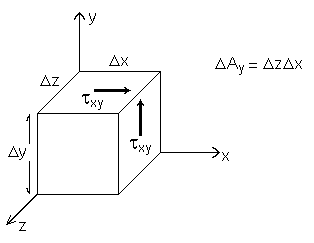The velocity of a fluid will vary in a complicated way in space; however, we can still apply the above definition of viscosity to a bit of fluid of thickness
![]() with an infinitesimal area
with an infinitesimal area ![]() . The shear stress across the thickness
. The shear stress across the thickness ![]() is
is
We can further generalize and define the xy component of the viscous stress tensor as
The notation is made clearer in Fig. 3.2.
This definition ensures that for a uniform rotation of the fluid there are no viscous stresses.
![]() 1
1

Figure 3.2: Stresses acting on a small cube.
We can apply the same arguments as above to
other flow configurations, with the result that the viscous stress tensor ![]() is given by
is given by
where i,j=(x,y,z).
![]() 2.
Now in a fluid we can have internal stresses due to the fluid pressure
p in addition to the stress due to viscous forces; the total stress
tensor
2.
Now in a fluid we can have internal stresses due to the fluid pressure
p in addition to the stress due to viscous forces; the total stress
tensor ![]() in the fluid is then
in the fluid is then
where ![]() is the Kronecker delta, defined such that
is the Kronecker delta, defined such that ![]() if i=j, and
if i=j, and ![]() otherwise. Once we have the
stress tensor, the force per unit volume of the fluid is obtained by considering the stresses acting upon an infinitesimal cube of the fluid, and
calculating the net force on the cube by taking the differences in the
stress acting on different faces (just like our calculation of the force arising from pressure gradients in the fluid). This results in derivatives
of the stress tensor, so that the ith component of the force per unit
volume is
otherwise. Once we have the
stress tensor, the force per unit volume of the fluid is obtained by considering the stresses acting upon an infinitesimal cube of the fluid, and
calculating the net force on the cube by taking the differences in the
stress acting on different faces (just like our calculation of the force arising from pressure gradients in the fluid). This results in derivatives
of the stress tensor, so that the ith component of the force per unit
volume is
If we work out this last sum, we find (assuming that the viscosity doesn't depend on position)
For an incompressible fluid ![]() ; reinstating vector
notation, we see that the sum is then just
; reinstating vector
notation, we see that the sum is then just ![]() , so that
the force per unit volume is
, so that
the force per unit volume is
This is the force which goes into Newton's Second Law in order to obtain the
equation of motion for ![]() :
:
This is the Navier-Stokes equation for an incompressible fluid. Along with the equation of continuity, it is the basic equation which governs the flow of Newtonian fluids.
To complete the description of the flow we need to specify the boundary
conditions on the velocity field at a solid surface. In our dealings with
nonviscous flow we imposed the condition that the normal component of the fluid velocity at a solid surface must be zero -- this just ensures that
no fluid flows through the surface. Once we deal with real (viscous) fluids, we must also require that the tangential component of the velocity of
the fluid be zero on the surface. This condition is often called the no-slip boundary condition, and is the result of experimental observations.
Footnotes:
![]() 1
To see this, notice that a fluid in uniform rotation with angular velocity
W will have a velocity field given by
v = W×r, with r the
displacement vector from the center of rotation. If the z axis is
the rotation axis, then vx = -Wy,
vy = Wx and we see that
txy = 0.
1
To see this, notice that a fluid in uniform rotation with angular velocity
W will have a velocity field given by
v = W×r, with r the
displacement vector from the center of rotation. If the z axis is
the rotation axis, then vx = -Wy,
vy = Wx and we see that
txy = 0.
![]() 2
This is the general result for an incompressible fluid; for compressible
fluids there is a second viscosity, often labeled z,
which will enter into the viscosity stress tensor. Since our discussion
of fluid mechanics is confined to incompressible fluids for the moment,
we will drop this term.
2
This is the general result for an incompressible fluid; for compressible
fluids there is a second viscosity, often labeled z,
which will enter into the viscosity stress tensor. Since our discussion
of fluid mechanics is confined to incompressible fluids for the moment,
we will drop this term.